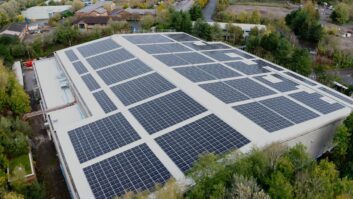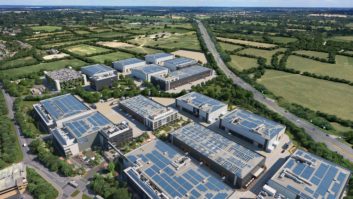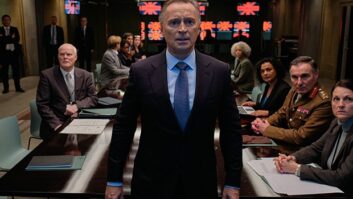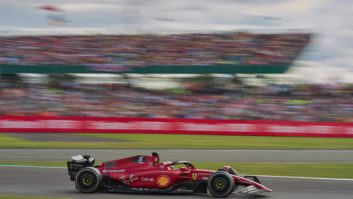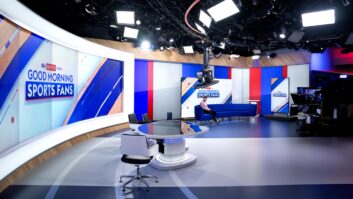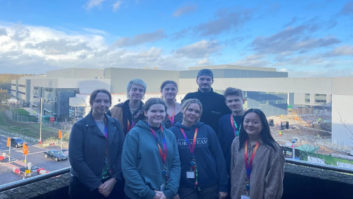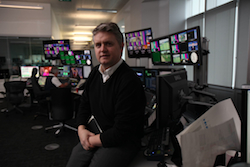
When production of Sky Sports News moved into the broadcaster’s new facility in west London last July, it marked the start of a six-month migration of other in-house departments. Last month saw the completion of that move, and Sky has been keen to point out the benefits of its new £233 million media centre – formerly known as Harlequin 1, now called, not surprisingly, Sky Studios. “When we broke ground for the new building in 2007, it meant that our growth as a broadcaster had achieved a new perspective,” says John Lennon, Sky’s director of Broadcast Operations and Strategy. “Previously, we had developed in a fast and dynamic way, but it was somewhat piecemeal. Now our efforts have been directed into a facility that can house 1300 personnel and will enable us to be far more efficient.” He says the new building is designed to Make, Shape and Share broadcast productions. To achieve that end there are eight studios to make the programmes, 45 edit suites to shape them and a formidable array of connectivity systems to share the material. “When it comes to making, all of the studios are equipped for both HD and 3D,” he says. “We can combine studios where audience participation is involved or there is a need for large scale productions. There is no disputing that we can offer world class facilities to our production partners.” He says the extra capacity will enable Sky to increase its creation of home-grown programmes. “Our production budget for 2011 was £380 million, but this is due to increase to £600 million over the next few years.” Lennon points out that Grass Valley has provided the LDK cameras and Kayak vision mixers for all the studios. With the exception of strategic key sources, all the lighting is based on LED technology. “We want to get the local community involved where it is appropriate, so we have built viewing galleries in some studios that will enable visitors to see what is going on – but without disrupting work on the production floor.” Tapeless from the start John Lennon is excited about one of its main production features — a completely tapeless environment. Having said that, he does concede that there are two tape machines in the building, just in case the need arises! “I am very enthusiastic about this aspect of the studios. Previously, on average, we had 4,500 movements of tape each day, and that is hardly efficient. We have had no resistance to the new technology, although I suppose there was some trepidation when the day for changeover was nearing. However, once it was used in a production situation, we found people were very relaxed about it and enjoyed the new technology.” Alongside the ability to edit at their desks, production staff have several ‘soft’ areas where they can take laptops to carry out the same function. Those areas can also be used for meetings and writing. To ensure these additional areas are fully efficient, the building has installed a robust Wi-Fi system. Lennon emphasises that training of staff is a priority and he will always make services available to ensure everyone is fully conversant with the technology changes. The move to a completely tapeless setting has seen Sky News and Sky Sports use Panasonic P2 as a standard for its single camera shooting. When the material arrives at the Sky Studios, both low and high resolution copies are made at the time of initial ingesting. The low res versions are then used for initial logging and editing. “The systems we use in the new facility include AVC-Intra, IMX 50, IBM disks and LTO-5 data tapes,” reports Lennon. Online editors have the use of 45 suites equipped with Avid systems, with some being complemented with EVS units where fast turnaround packages are needed. In addition, there are 12 international commentary booths and an associated control room that can handle eight live events simultaneously. For sharing Sky has developed a comprehensive network of communication around the building. At the heart of the tapeless operation are Omneon servers for both ingest and playout. “We can accommodate 160 feeds coming into the building from all over the world. We used to have line up in one building and the video tape recording in another. That was not very efficient. Now all ingest and outgest facilities are co-located on one floor,” says Lennon. The feeds are directed into the Ardendo Media Asset Management system supplied by VizRT and are instantly available to the relevant departments. Editing can begin within moments of the material arriving. “We are more interested in quality than quantity,” Lennon emphasises. “Our feeds are set at 100 megabytes, and we made a decision some time ago that we would only operate three channels on one transponder – and with Sky Sports this is reduced to two channels.” He continues, “Our tapeless system has Quality Control checks built in using a Cerify by Tektronix system. However, we also carry out some traditional QC checks so that our quality is second to none.” Environmental equations Beyond the technical specification of the new building, Lennon explains that the design has also taken into account the actual working environment – and, of course, ‘green’ considerations. “We spent a great deal of time evaluating workflows, so that people’s working conditions are the most efficient. We have done away with the concept, ‘this is a technical area and this is an office space’. They are all integrated to make life easier. “Generally speaking, the areas where people are working are on the outside of the building, enabling them to have windows to see what is going on outside. Today’s viewing screens are such that you no longer have to work in a darkened room.” Lennon says that creating a sustainable environment was a priority. “We don’t just pay lip service to these considerations. When companies were bidding to provide goods and services, they had to show they had thought about the question of sustainability. Woven into every aspect of the facility are sustainable elements – right down to the carpet tiles and windows.” Through the use of 13 ‘chimneys’ in the stairwells, natural ventilation for 65% of the building has been achieved. Other ‘green’ factors include recycled rainwater being used to flush toilets. Located close to the building is a wind vane that produces enough electricity to power to light the whole facility with the exception of the studio lighting grids. In fact, the building has achieved an A Star rating for its energy efficiency. “We believe this is the most sustainable broadcast facility in Europe,” states Lennon. “We have tried to be progressive so we can produce the very best output for our viewers.” He concludes, “It is an important factor that we do not just think about clever technical innovations, although we do have that, of course. Rather what we do is deliver creative content from this new building. I like to think about it as a factory of ideas.” www.sky.com
